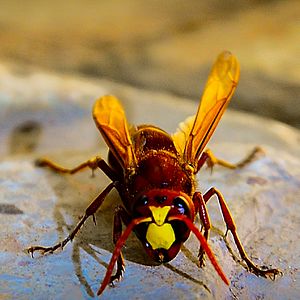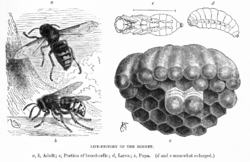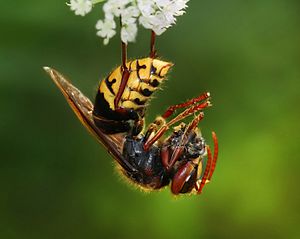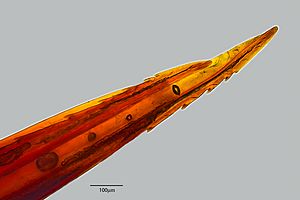Hornet facts for kids
Quick facts for kids Hornet |
|
|---|---|
 |
|
| Oriental hornet (Vespa orientalis) | |
| Scientific classification |
|
| Kingdom: | Animalia |
| Phylum: | Arthropoda |
| Class: | Insecta |
| Order: | Hymenoptera |
| Family: | Vespidae |
| Subfamily: | Vespinae |
| Genus: | Vespa Linnaeus, 1758 |
| Type species | |
| Vespa crabro Linnaeus, 1758
|
|
| Species | |
|
See text |
|
Hornets are large wasps. They belong to a group of insects called Vespa. Hornets are the biggest of the social wasps. They look a lot like their close relatives, yellowjackets. Some hornets can grow to be about 5.5 centimeters (2.2 inches) long.
You can tell hornets apart from other wasps by the large top part of their head. There are 22 known types of hornets around the world. Most of these live in warm, tropical parts of Asia. However, the European hornet (Vespa crabro) lives in many places. You can find it across Europe, Russia, North America, and northeast Asia. Some wasps in North America are called hornets, like the baldfaced hornet. But these are actually types of yellowjackets, not true hornets.
Like other social wasps, hornets build nests together. They chew wood to make a material that feels like paper. Each nest has one queen hornet. She lays all the eggs. Worker hornets, who are female, take care of the queen and the nest. They cannot lay fertile eggs themselves. Most hornets build their nests out in the open, often in trees or bushes. But some, like the Vespa orientalis, build their nests underground or in other hidden spots.
In warm places, hornet nests can last all year. But in colder areas, the nest dies in winter. Only the queen hornet survives by hiding in places like leaf litter until spring. Male hornets are calm and do not have stingers.
People sometimes see hornets as pests. This is because they strongly protect their nests if they feel threatened. Hornet stings can also be more painful than bee stings.
Contents
What are Hornets?
Hornets are a specific type of wasp. They are part of the same family as yellowjackets. Sometimes, other large wasps are mistakenly called hornets. For example, the bald-faced hornet in North America is not a true hornet. It is black and white and builds nests in the air, similar to some true hornets. But it is actually a yellowjacket. Another example is the Australian hornet, which is a type of potter wasp.
Where Hornets Live
Hornets mostly live in the Northern Half of the world. The European hornet (Vespa crabro) is the most common type. It lives widely across Europe, Ukraine, and parts of Russia. It also lives in southern Siberia and eastern China.
The European hornet was accidentally brought to eastern North America in the mid-1800s. It now lives there in similar climates to Europe. However, you won't find it in western North America.
The Asian giant hornet (Vespa mandarinia) lives in parts of Russia, China, Korea, and Japan. It is very common in the mountains of Japan. People there often call it the "giant sparrow bee."
The Oriental hornet (Vespa orientalis) lives in dry, warm areas of central Asia and southern Europe. This includes countries like Italy, Greece, and Turkey.
The Asian hornet (Vespa velutina) has recently spread to France, Spain, Portugal, and Italy.
Hornet Stings
Hornets use their stingers to catch food and protect their nests. Hornet stings can hurt more than typical wasp stings. This is because hornet venom has a lot of a chemical called acetylcholine.
Unlike honey bees, hornets can sting many times. Their stingers are very smooth and do not get stuck in the skin. This means they can pull their stinger out easily and sting again.
How dangerous a hornet sting is depends on the type of hornet. Some stings are like a normal insect sting. Others are from some of the most venomous insects known. A single hornet sting is usually not deadly to humans. However, it can be very dangerous for people who are allergic to wasp venom. Many stings from some hornet species can be fatal. This is due to powerful toxins in their venom.
The stings of the Asian giant hornet (Vespa mandarinia) are known to be very venomous. They cause many deaths each year in Japan and China. Their venom can cause serious allergic reactions and organ failure.
If someone is allergic to wasp venom, they might also be allergic to hornet stings. Allergic reactions are often treated with an epinephrine autoinjector. After this, it's important to get medical help at a hospital. In serious cases, allergic people can go into anaphylactic shock. This can be deadly if not treated quickly.
Hornet Attack Signals
Hornets, like many social wasps, can call their whole nest to attack if they feel threatened. This can be very dangerous for humans and animals. They release a special chemical signal called a pheromone when their nest is in danger.
The Asian giant hornet also uses this signal when they attack honey bee colonies. This helps many worker hornets join the attack at once. If a hornet is killed near its nest, it might release these signals. This can make other hornets attack anything that has the signal on it. This includes clothes, skin, or even dead hornets. Some food smells, like banana or apple, can also trigger an attack.
Hornet Life Cycle
For the European hornet (Vespa crabro), a new nest starts in spring. A fertilized female, called the queen, builds it. She usually chooses a safe place, like a hollow tree trunk. First, she builds up to 50 small cells from chewed tree bark. These cells are in flat layers called combs. Each cell stands upright and is closed at the top. The queen then lays one egg in each cell.
After about 5 to 8 days, the egg hatches. Over the next two weeks, the young hornet, called a larva, grows through five stages. During this time, the queen feeds the larva a lot of protein from insects. Then, the larva spins a silk cap over its cell. For the next two weeks, it changes into an adult hornet. This process is called metamorphosis. The adult then chews its way out of the silk cap.

These first adult hornets are always females. They become the workers. They start doing all the jobs the queen used to do. This includes finding food, building the nest, and taking care of the young. Only the queen continues to lay eggs.
As the hornet colony grows, new combs are added. A cover is built around the cells until the whole nest is hidden. There is only one entrance hole. At its busiest time in late summer, a colony can have up to 700 workers.
At this point, the queen starts to produce new queens and males. Fertilized eggs become new female queens. Unfertilized eggs become males, sometimes called "drones." Adult male hornets do not help with nest work or finding food. In early to mid-autumn, they leave the nest to mate.
Other hornets in colder areas have similar life cycles. Hornets in tropical places might have different life cycles.
What Hornets Eat
Adult hornets eat nectar and other sugary plant foods. You can often find them eating sap from oak trees, rotting sweet fruits, or honey. They often fly into fruit orchards to eat overripe fruit. They might chew a hole in a fruit and get completely inside it. If someone accidentally picks a fruit with a hornet inside, the hornet might sting them.
Adult hornets also hunt other insects. They kill their prey with stings and strong jaws. Because of their size and powerful venom, hornets can kill large insects. This includes honey bees, grasshoppers, and locusts. They chew up their prey and feed it to the young hornets (larvae) in the nest. Adult hornets do not eat the prey themselves. Since hornets eat some insects that are considered pests, they can sometimes be helpful.
The hornet larvae produce a sweet liquid. This liquid contains sugars and amino acids. The worker hornets and queens eat this liquid.
Hornet Species
There are many different types of hornets. Here are some of them:
- Vespa affinis
- Vespa analis
- Vespa basalis
- Vespa bellicosa
- Vespa bicolor
- Vespa binghami
- Vespa crabro
- Vespa ducalis
- Vespa dybowskii
- Vespa fervida
- Vespa fumida
- Vespa luctuosa
- Vespa mandarinia
- Vespa mocsaryana
- Vespa multimaculata
- Vespa orientalis
- Vespa philippinensis
- Vespa simillima
- Vespa soror
- Vespa tropica
- Vespa velutina
- Vespa vivax
Well-Known Hornet Types
- Asian giant hornet (Vespa mandarinia)
- Asian hornet (Vespa velutina)
- black-bellied hornet (Vespa basalis)
- European hornet (Vespa crabro)
- greater banded hornet (Vespa tropica)
- lesser banded hornet (Vespa affinis)
- Oriental hornet (Vespa orientalis)
- yellow hornet (Vespa simillima)
- Vespa luctuosa (this species has very strong venom)
Hornets as Food and Medicine
In some mountain areas of China, hornet larvae are eaten as food. Hornets and their nests are also used in traditional Chinese medicine.
Images for kids
See also
 In Spanish: Avispón para niños
In Spanish: Avispón para niños






